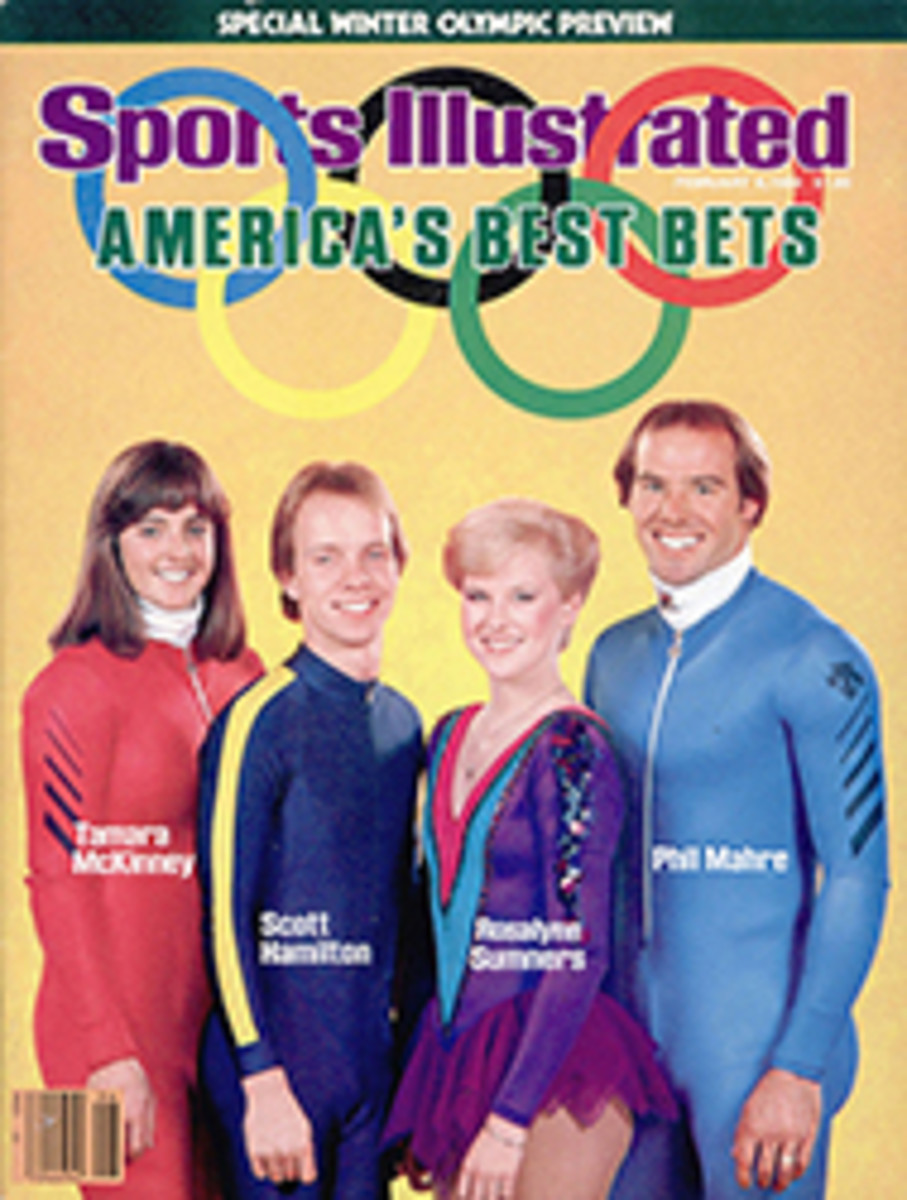
A Long Jump That'll Be Long Remembered
All eyes in the sellout crowd of 18,210 in New York's Madison Square Garden were focused on one man. Even athletes warming up or competing in the other field events turned to watch. Only the six runners waiting at the line for the start of the 800 and a few dedicated inspectors weren't staring at the head of the long-jump runway. In the galvanizing moment of last Friday night's Wanamaker Millrose Games, Carl Lewis slowly rocked front-to-back, nervously licking his lips. His sister-cheerleader-jumping assistant, Carol, sat midway up the banked track behind him, muscles taut, her heels braced against the plywood runway extension on which he stood. The unattached plywood had slipped out from under Lewis on three of his earlier jumps—disastrously. Entering the final jump in the sixth and final round, he was in second place, over three inches behind Larry Myricks, who had just equaled the best indoor jump of his life, 27'6". "Normally I go out there and jump and boom," said Lewis later, but here at the Millrose, after 30 consecutive long-jump victories spanning nearly three years, he seemed destined to go pffffffft.
From its start, the evening had been anything but smooth for the 22-year-old Lewis. He had found the Garden's wooden jump runway badly flawed—soft spots; loose boards; that slip-sliding extension piece that gave him only 152 feet of his customary 165-foot approach; and a takeoff board located only 28'6" from the rear of the landing pit because the runway had been incorrectly assembled. Having jumped as far as 28'10¼" outdoors and a world-record 28'1" indoors, and in shape to match either of those marks, Lewis was relieved when an official spotted the assembly error and workmen scurried out to perform the corrective carpentry. "This track needs a retirement," sighed Carol.
With his slipping starts and shortened run-up, Carl didn't produce even a 27-foot jump on his first three tries. At the end of each approach he was forced to decelerate and chop his steps in order to hit the takeoff board properly. "He was crowding the board," said his coach, Tom Tellez of the University of Houston. "The harder he tried, the worse it got."
Still, as poorly as Lewis was jumping, his four rivals were faring worse; through three rounds none had come within 18 inches of Lewis' best, 26'11¼". As the fourth round began, Lewis slipped into his black crushed-velvet warmup suit and announced he was passing. He wouldn't test that run-in again unless he had to.
But Myricks brought Lewis back with a 27'3¼". "What Carl's done in the long jump has made it easier for all of us to go farther," said Myricks, 27, the 1979 World Cup champion and onetime world indoor record holder (27'6"). "A lot of people's heads have changed since he broke through." Myricks, who was the world's top-ranked long jumper in 1979, is the last man to beat Lewis indoors (1981 TAC Championships) or outdoors (1980 Olympic Trials). But since trading wins (2-2) in 1981, Lewis has handled Myricks with ease—in both jumping and Myricks' other specialty, the 200 meter. Still, said Myricks, "I know he can be beaten."
That prospect—defeat—was facing Lewis as he conferred at trackside with his sister, Tellez and coach Joe Douglas of the Santa Monica Track Club, Lewis' agent and manager. Carol, a junior majoring in communications at Houston, reminded the others that in a recent meet in Osaka, Japan, she, too, had had trouble with a slipping stretch of long-jump runway and had gotten several Japanese to hold it steady for her. She had subsequently improved her American indoor record to 21'10¾" at that meet. "We decided someone should hold the board for Carl," said Tellez later, "but Carol wasn't going to wait for anybody. She went right down there herself."
Carol, who until then had been busy running the women's 60-yard hurdles (she finished fifth) and checking to see if Carl was hitting the right check marks on his approaches (he wasn't), locked her 5'10", 150-pound frame into position behind the plywood runway extension and braced the board in place with her feet as her brother took off toward the pit on his fifth jump. Unfortunately, Carl's steps were still off. He hit the sand at 27'2¾", half an inch shy of Myricks' mark.
"Move back about six or eight inches when you start next time," Tellez advised Lewis. Then together they watched Myricks soar to his last-round 27'6". "I didn't have to tell Carl anything more," said Tellez. "He knew what he had to do."
What Lewis did on his final jump was charge down the runway like the world's greatest sprinter, which he is, and hit his check marks like the world's greatest long-jump technician, which, thanks to Tellez, he also is. After 152 feet of dead-out sprint, he planted his right foot on the takeoff board so close to the Plasticene fouling strip that the overseeing judge later said Lewis had been "one one-hundredth of a millimeter"—less than the thickness of tissue paper—from a foul. The 6'2", 176-pound Lewis flew out over the sand, a churning, self-propelled windmill of arms and legs, rising, soaring, straining toward the island of photographers beyond the pit. The crowd sat in hushed awe. Lewis floated downward. He hit the sand, easily a foot past Myricks' best, and the Garden rocked with noise. Instantly Lewis shot to his feet and bounded out of the pit, a massive smile splitting his face and both fists triumphantly raised. Joyously he threaded his way between crouching officials and the pack of 800-meter runners, now just rounding the turn at the outside of the long-jump pit, to meet Carol and share a high five. A moment later Carol had Carl around the waist and was lifting him up. "Lighter than my squats," she said. "When a long jumper gets a good one, he knows" said Carl.
Then the announcement came: Lewis had not merely won the long-jump competition, but he had also broken the meet record and the world indoor record and had equaled his own personal best. He had jumped a phenomenal 28'10¼", a performance second only to Bob Beamon's 1968 world record of 29'2½", which came at high altitude in Mexico City, off a full-length, top-quality runway and with a 4.473-mph (2.0 meter-per-second) aiding wind. It clearly was, as Lewis called it, "the best jump of my life." At least until next time. The jump—which experts say would convert to 30 feet outdoors under ideal conditions—also meant that Lewis now has the 11 best indoor marks in history, a domination unmatched at present by any other athlete in any other indoor event. Myricks' consolation was that the 27'6" he leaped on Friday equaled history's longest indoor jump by someone other than Carl Lewis.
"This just shows that Carl has a Jerry West style, that he can concentrate and perform when he has to," said Douglas afterward. In winning his one world and five national long-jump titles, Lewis had never faced such pressure on a single jump. But he's utterly confident of his physical talents and remarkably poised, and his pre-Mill-rose training had given him further encouragement.
"I knew something was in the making when I talked to Carl this morning," Douglas said. "It was like he was trying to hide something. I asked him about his training with Tellez this week, and he said, 'Well, I had a good workout.' Then he said, 'You just watch.' "
Lewis, it turned out, had had two excellent workouts with Tellez in Houston. One had been a session of runway work and the other a series of short-run jumps—executed after a run-up of only 70 or 80 feet, barely half the normal distance. "I don't know if he and Tellez want people to know," said Douglas, "but I believe Carl jumped three times over 26 with an eight-step run."
"It wasn't a question of how far he jumped," said Tellez. "What mattered was how he jumped."
Lewis was crediting his performance in part to his decision last fall to lose some weight. "In my case, three or four pounds can mean inches," he said, and in fact he has shed eight pounds. "I'm stronger even though I'm lighter." Lewis' hyperactivity since last summer's World Championships has helped reduce his weight, too. In addition to making personal appearances and giving interviews—Douglas fielded an average of 17 interview requests a day for him last season—Lewis, a former communications major at Houston, has started reporting sports a few hours a week for the ABC-TV affiliate in that town. He also recorded an as-yet-unreleased single called Going for the Gold in San Francisco with Narada Michael Walden, a rhythm and blues artist and producer ("He said my voice wasn't too bad," says Carl). Lewis even spent two weeks in New York studying acting with Warren Robertson, whose students have included Jessica Lange. "I found I'm more emotional and sensitive than I thought I was," says Lewis, who read the Gale Sayers role from Brian's Song in a Robertson workshop. "Athletes are always taught to suppress their feelings."
Lewis was euphoric as Friday's meet moved toward its conclusion. He was also, it seemed, curious. While the final races were going off, he and Douglas were at trackside examining his jumping shoes. "Look at this," said Douglas, holding up Lewis' takeoff shoe. Lewis was mildly startled to discover that in his record jump he had sheared off two spikes. That noted, Lewis took the shoe from Douglas. He studied the toe, which was streaked with red paint from the runway. He scraped at it with a fingernail, then looked at his nail. "Just paint," said Lewis. "No Plasticene."
"I told you the jump was legal," said Douglas.
Lewis smiled. "I know," he said,
TWO PHOTOS
As astounded officials studied the tape, Lewis raised his arms in triumph (inset), having beaten his previous world mark by 9¼".
PHOTO
Myricks' 27'6" put more pressure on.
TWO PHOTOS
Tellez and Carol Lewis conferred with Carl between jumps; later, Carol lent a helping hand for her brother's stunning leap (left).

